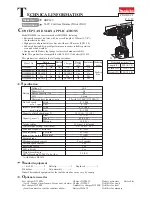
14
| English
Cordless Drill/Driver
PSR 1440 LI-2 PSR 1800 LI-2 PSR 1810 LI-2 PSR 1820 LI-2
PSR 180 LI-8
Recommended chargers
AL 18...
C)
AL 18...
C)
AL 18...
C)
AL 18...
C)
AL 18...
C)
A) Depends on battery in use
B) Limited performance at temperatures <0 °C
C) The following chargers are not compatible with the PBA rechargeable battery: AL 1814 CV, AL 1820 CV, AL 1860 CV
Noise/vibration information
Noise emission values determined according to
EN 62841-2-1
.
Typically, the A-weighted sound pressure level of the power
tool is
71
dB(A). Uncertainty K=5 dB. The noise level when
working can exceed the volume stated.
Wear hearing pro-
tection!
Vibration total values a
h
(triax vector sum) and uncertainty K
determined according to
EN 62841-2-1
:
Drilling into metal: a
h
<
2.5
m/s
2
, K =
1.5
m/s
2
,
Screwdriving: a
h
<
2.5
m/s
2
, K =
1.5
m/s
2
The vibration level and noise emission value given in these
instructions have been measured in accordance with a
standardised measuring procedure and may be used to com-
pare power tools. They may also be used for a preliminary
estimation of vibration and noise emissions.
The stated vibration level and noise emission value repres-
ent the main applications of the power tool. However, if the
power tool is used for other applications, with different ap-
plication tools or is poorly maintained, the vibration level
and noise emission value may differ. This may significantly
increase the vibration and noise emissions over the total
working period.
To estimate vibration and noise emissions accurately, the
times when the tool is switched off or when it is running but
not actually being used should also be taken into account.
This may significantly reduce vibration and noise emissions
over the total working period.
Implement additional safety measures to protect the oper-
ator from the effects of vibration, such as servicing the
power tool and application tools, keeping their hands warm,
and organising workflows correctly.
Assembly
u
Remove the battery from the power tool before carry-
ing out work on the power tool (e.g. maintenance,
changing tool, etc.). The battery should also be re-
moved for transport and storage.
There is risk of injury
from unintentionally pressing the on/off switch.
Charging the Battery
u
Use only the chargers listed in the technical data.
Only
these chargers are matched to the lithium-ion battery of
your power tool.
Note:
The battery is supplied partially charged. To ensure
full battery capacity, fully charge the battery in the charger
before using your power tool for the first time.
The lithium-ion battery can be charged at any time without
reducing its service life. Interrupting the charging process
does not damage the battery.
The lithium-ion battery is protected against deep discharge
by the "Electronic Cell Protection (ECP)". When the battery
is discharged, the power tool is switched off by means of a
protective circuit: The application tool no longer rotates.
u
Do not continue to press the On/Off switch after the
power tool has automatically switched off.
The battery
can be damaged.
Follow the instructions on correct disposal.
Removing the battery (see figure A)
To remove the battery
(8)
, press the release button
(7)
and
pull the battery back and out of the power tool.
Do not use
force to do this.
Battery Charge Indicator
When the on/off switch
(12)
is pressed in halfway or com-
pletely, the battery charge-control indicator
(10)
indicates
the charge condition of the battery for several seconds. The
indicator consists of three green LEDs.
LED
Capacity
Continuous light 3 x green
≥ 75 %
Continuous light 2 x green
50–75 %
Continuous light 1 x green
26–50 %
Slowly flashing light 1 x green
≤ 25 %
The three LEDs in the battery charge indicator flash
quickly when the temperature of the battery is outside
the operating temperature range of –30 to +65 °C and/or
the overload protection has been triggered.
Changing the tool (see figure B)
The drill spindle is locked when the on/off switch
(12)
is not
pressed. This makes it possible to change the application
tool in the drill chuck quickly, conveniently and easily.
Open the keyless chuck
(2)
by turning it in the direction of
rotation
➊
until the tool can be inserted. Insert the tool.
Firmly tighten the sleeve of the keyless chuck
(2)
by turning
it by hand in the direction of rotation
➋
until it audibly clicks
into place. This will automatically lock the drill chuck.
The lock will disengage again if you turn the sleeve in the op-
posite direction to remove the tool.
Dust/Chip Extraction
Dust from materials such as lead-containing coatings, some
wood types, minerals and metal can be harmful to one’s
health. Touching or breathing-in the dust can cause allergic
1 609 92A 4WD | (12.12.2019)
Bosch Power Tools















































